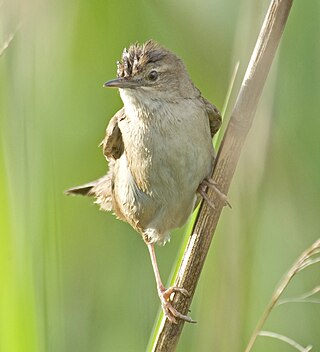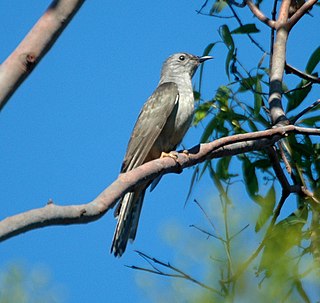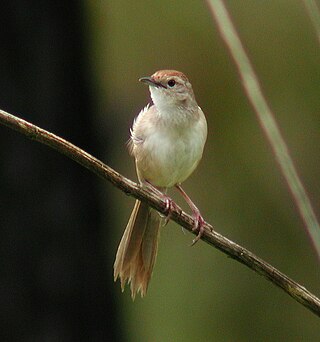Old World warblers are a large group of birds formerly grouped together in the bird family Sylviidae. They are not closely related to the New World warblers. The family held over 400 species in over 70 genera, and were the source of much taxonomic confusion. Two families were split out initially, the cisticolas into Cisticolidae and the kinglets into Regulidae. In the past ten years they have been the subject of much research and many species are now placed into other families, including the Acrocephalidae, Cettiidae, Phylloscopidae, and Megaluridae. In addition some species have been moved into existing families or have not yet had their placement fully resolved. A smaller number of warblers, together with some babblers formerly placed in the family Timaliidae and the parrotbills, are retained in a much smaller family Sylviidae.

The grass warblers are small passerine birds belonging to the genus Locustella. Formerly placed in the paraphyletic "Old World warbler" assemblage, they are now considered the northernmost representatives of a largely Gondwanan family, the Locustellidae.

Bradypterus is a genus of small insectivorous songbirds ("warblers") in the newly recognized grass warbler family (Locustellidae). They were formerly placed in the Sylviidae, which at that time was a wastebin taxon for the warbler-like Sylvioidea. The range of this genus extends through the warm regions from Africa around the Indian Ocean and far into Asia.

The New Zealand fernbird or simply fernbird is an insectivorous bird endemic to New Zealand. In the Māori language, it is named kōtātā or mātātā.

The brush cuckoo is a member of the cuckoo family.

The bristled grassbird is a small passerine bird in the genus Schoenicola. Also known as the bristled grass warbler, this species is endemic to the Indian subcontinent, where it is patchily distributed in Bangladesh, India, Nepal and Pakistan. These insectivorous birds skulk in dense and tall grasslands, often in marshy areas, habitats that are threatened by human activities. Formerly considered to be sedentary, the species may be migratory, moving south and east in the Indian peninsula during winter and returning to their breeding grounds in the northern plains south of the Himalayas.

The brown songlark, also Australian songlark, is a small passerine bird found throughout much of Australia. A member of the family Locustellidae, this species is notable for sexual size dimorphism, among the most pronounced in any bird. It is a moderate-sized bird of nondescript plumage; the female brownish above and paler below, the larger male a darker brown.

Cincloramphus is a genus of birds in the grassbird family Locustellidae.

The rufous songlark is a species in the family Locustellidae endemic to Australia.

The Fly River grassbird is a species of Old World warbler in the family Locustellidae. It is found in Indonesia and Papua New Guinea. Its natural habitats are freshwater marshes and lakes. It is threatened by habitat loss.

The striated grassbird is an "Old World warbler" species in the family Locustellidae. It was formerly placed in the family Sylviidae. It is now the only species placed in the genus Megalurus.

The tawny grassbird is a large songbird that is part of the grass- and bush-warbler family (Locustellidae) commonly found in grassland and reedbed habitats. It is streaked above and has a distinctive rich brown cap. Its underside is paler and it has a long graduated tail. They call often with "loud, grumpy churring calls and a longer call that starts tick-tick-tick-tick and ends with an explosive descending trill".

The broad-tailed grassbird is a species of Old World warbler in the family Locustellidae. It is endemic to the Western Ghats of India with a possibility of occurrence in Sri Lanka. A small, mostly brown bird, it has a broad rounded and graduated tail. It is found only on the higher altitude grassy hills where it usually skulks, except during the breeding season when males fly up into the air to sing in their display. The species is believed to be a resident although it is possible that they make local movements.

Locustellidae is a newly recognized family of small insectivorous songbirds ("warblers"), formerly placed in the Old World warbler "wastebin" family. It contains the grass warblers, grassbirds, and the Bradypterus "bush warblers". These birds occur mainly in Eurasia, Africa, and the Australian region. The family name is sometimes given as Megaluridae, but Locustellidae has priority.

The Australian crake , also known as Australian spotted crake, or spotted crake is a species of bird in the family Rallidae. It is the only species of Australian crake in the genus Porzana.

The African warblers are a newly erected family Macrosphenidae, of African songbirds. Most of the species were formerly placed in the Old World warbler family Sylviidae, although one species, the rockrunner, was placed in the babbler family, Timaliidae. A series of molecular studies of the Old World warblers and other bird families in the superfamily Sylvioidea found that the African warblers were not part of Sylviidae but were instead an early (basal) offshoot of the entire clade Sylvioidea. Some taxonomic authorities place the entire family Hyliidae here.

The Bicol ground warbler is a species of passerine bird in the family Locustellidae. It is endemic to the island of Luzon in the Philippines, where it is found in the southern parts of the island. Along with its other conspecifics, such as the Cordillera ground warbler and the Sierra Madre ground warbler, it is one of the most elusive birds in the country. Its natural habitat is tropical moist lowland forest. It is threatened by habitat loss.
The Guadalcanal thicketbird is a bird species. It used to be placed in the "Old World warbler" family Sylviidae, but it does not seem to be a close relative of the typical warblers; it belongs in the grass warbler family, Locustellidae. It is found on the island of Guadalcanal in the Solomon Islands.

Poodytes is a genus of passerine birds in the grassbird family Locustellidae.




















